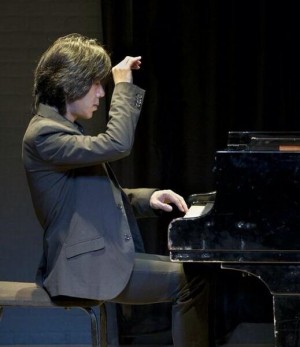Acclaim
Review
MANO DE HIERRO, GUANTE DE TERCIOPELO (Steel Hands, Velvet Gloves)

MANO DE HIERRO, GUANTE DE TERCIOPELO
El pianista japonés brilló con la integral de Pierre Boulez.
Con la obra completa para piano solo de Pierre Boulez, el japonés Taki Kigawa abrió el jueves la nueva edición de Integrales del Centro de Experimentación del Colón (que continuó anoche con los cuartetos de Kagel por el Cuarteto de la UNTREF y concluye hoy con la música para piano de Berio por Haydée Schvartz).
En la obra pianística de Boulez hay un hiato de más de cuatro décadas; entre la Tercera sonata, completada en 1957 aunque revisada en más de una ocasión, e Incises, de 2001, el autor no escribió música para piano solo; e incluso en compañía de otros instrumentos el piano no tuvo mayor protagonismo excepto en una obra como Eclat (1965). Ese hiato es temporal y, desde luego, estilístico. Tal vez por el hecho de haber sido escrita especialmente para un concurso de piano, el Umberto Micheli de Milán, Incises se recorta como algo diferente dentro de la obra de Boulez; y, cosa rara en el músico francés, tampoco reelabora materiales de otras piezas. Lejos de la idea de variación a gran escala, Incises no evita las figuras recurrentes ni la filosofía del estudio virtuosista, aunque sin perder la apariencia de una encantadora improvisación. Su interpretación requiere, como dijo Boulez en una conversación con András Varga, “manos de hierro en guantes de terciopelo”, y exactamente así lo transmitió el formidable Taka Kigawa: con extrema precisión y tersura.
La producción pianística de Boulez no se detuvo en Incises. Cuatro años después el autor escribió una nueva pieza de cuatro minutos que tituló Página de efeméride. Como Incises, tiene también un propósito pedagójico (el “Piano Project” de la editorial de música contemporánea Universal), pero su estilo es muy diferente; en cierta forma lleva al piano ciertos gestos orquestales y ornamentales que se volvieron su marca registrada.
Además de las tres Sonatas (la primera, de 1946; la segunda; de 1948; la tercera, en una versión de 1963), la selección de Kigawa rescató una obra de la prehistoria pianística del músico francés: las Doce Notationes, que prácticamente desaparecieron del catálogo para volver transformadas en las Notaciones para orquesta.
Si bien están basadas en una serie dodecafónica (el número doce es omnipresente: cada pieza posee además doce compases), estas piezas tienen una belleza tímbrica y cierta resonancia acampanada que las sonatas dejaron un poco de lado y que Kigawa exploró magistralmente. Las Notaciones crecieron en una hermosa tierra ambigua entre el impresionismo y el serialismo de posguerra.
---
English Translation
STEEL HANDS, VELVET GLOVES
The Japanese pianist shined with the complete piano works by Pierre Boulez
On Thursday, Japanese pianist Taka Kigawa played the complete works for piano by Pierre Boulez to open the new edition of Integrales of the Centro de Experimentacion del Colon (it continued last night with Kagel’s string quartets played by the Cuarteto de la UNTREF, and concludes tonight with Berio’s piano music played by Haydee Schwartz).
In Boulez’ work for the piano, there is a gap of more than four decades; between the Third Sonata, completed in 1957 although revised more than once, and Incises, from 2001, the author did not write music for solo piano; and even in the company of other instruments, the piano did not play a major role except in a work like Eclat (1965). This break is temporal and, of course, stylistic. Maybe because it was written specifically for a piano competition (the Umberto Micheli of Milan), Incises stands out as something different in Boulez’ work; and, a rarity for the French musician, it doesn’t reuse material from other pieces. Incises is far from the idea of large-scale variation, it does not avoid recurring figures or the philosophy of virtuosity, and yet maintains the appearance of enchanting improvisation. Its interpretation requires, as Boulez said in a conversation with Andras Varga, “steel hands in velvet gloves,” and that’s exactly like the formidable Taka Kigawa performed it: with extreme precision and smoothness.
The pianistic output of Boulez didn’t stop with Incises. Four years later, the author wrote a new, four-minute long work entitled Une page d’éphéméride. Like Incises, it also has a pedagogic purpose (the “Piano Project” of the contemporary music publisher Universal Edition), but its style is much different; in a certain way, he transfers to the piano some of his trademark orchestral and ornamental gestures.
In addition to the three Sonatas (the first, from 1946; the second, from 1948; the third, in a version from 1963), Kigawa’s selection rescued a work from the pianistic pre-history of the French musician: the Douze Notations, which have practically disappeared from the catalog to return transformed into Notations for Orchestra.
Even though they are based on a dodecaphonic row (the number twelve is omnipresent: each piece is also twelve measures long), they have a timbral beauty and bell-like sound that the sonatas casted aside, and that Kigawa explored masterfully. The Notations grew on a beautiful, ambiguous ground between impressionism and post-war serialism.
(Translation by Itsaso Garcia-Acros & Miro Magloire)